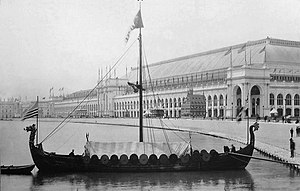
Longships were a type of specialised Scandinavian warships that have a long history in Scandinavia, with their existence being archaeologically proven and documented from at least the fourth century BC. Originally invented and used by the Norsemen for commerce, exploration, and warfare during the Viking Age, many of the longship's characteristics were adopted by other cultures, like Anglo-Saxons, and continued to influence shipbuilding for centuries.

The World's Columbian Exposition, also known as the Chicago World's Fair, was a world's fair held in Chicago from May 5 to October 31, 1893, to celebrate the 400th anniversary of Christopher Columbus's arrival in the New World in 1492. The centerpiece of the Fair, held in Jackson Park, was a large water pool representing the voyage that Columbus took to the New World. Chicago won the right to host the fair over several competing cities, including New York City, Washington, D.C., and St. Louis. The exposition was an influential social and cultural event and had a profound effect on American architecture, the arts, American industrial optimism, and Chicago's image.

Viking ships were marine vessels of unique structure, used in Scandinavia from the Viking Age throughout the Middle Ages. The boat-types were quite varied, depending on what the ship was intended for, but they were generally characterized as being slender and flexible boats, with symmetrical ends with true keel. They were clinker built, which is the overlapping of planks riveted together. Some might have had a dragon's head or other circular object protruding from the bow and stern for design, although this is only inferred from historical sources. Viking ships were used both for military purposes and for long-distance trade, exploration and colonization.

Jackson Park is a 551.5-acre (223.2 ha) urban park located on the South Side of Chicago. The park was designed in 1871 by Frederick Law Olmsted and Calvert Vaux, then greatly remodeled in 1893 to serve as the site of the World's Columbian Exposition, making it one of the largest and most historically significant parks in the city.

The Gokstad ship is a 9th-century Viking ship found in a burial mound at Gokstad in Sandar, Sandefjord, Vestfold, Norway. It is displayed at the Viking Ship Museum in Oslo, Norway. It is the largest preserved Viking ship in Norway.

William Le Baron Jenney was an American architect and engineer known for building the first skyscraper in 1884.

The Oseberg ship is a well-preserved Viking ship discovered in a large burial mound at the Oseberg farm near Tønsberg in Vestfold county, Norway. This ship is commonly acknowledged to be among the finest artifacts to have survived from the Viking Age. The ship and some of its contents are displayed at the Viking Ship Museum at Bygdøy on the western side of Oslo, Norway.

The Heritage Hjemkomst Interpretive Center, commonly known as the Hjemkomst Center, is a museum in Moorhead, Minnesota. Hjemkomst Center first opened in 1985 and serves as a home to Hjemkomst Viking Ship, Hopperstad Stave Church replica, quarterly museum exhibits, and county archives. In 2009, the Clay County Historical Society and the Heritage Hjemkomst Interpretive Center merged to form the Historical and Cultural Society of Clay County.
Richard W. Bock was a German-born American sculptor known for his collaborations with the American architect Frank Lloyd Wright. He was particularly known for his sculptural decorations for architecture and military memorials, along with the work he conducted alongside Wright.

Little Norway was a living museum of a Norwegian village located in Blue Mounds, Wisconsin. Little Norway consisted of a fully restored farm dating to the mid-19th century. It is listed on the National Register of Historic Places.
Geneva Community High School, or GHS, is a public high school located in Geneva, Illinois, a western suburb of Chicago, Illinois, in the United States. It is part of Geneva Community Unit School District 304.
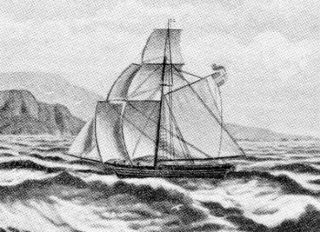
Restauration was a sloop built in 1801, in Hardanger, Norway. It became a symbol of Norwegian American immigration. Historical sources may contain several variations on the name of the sloop, including Restauration, Restoration, Restaurasjonen, and Restorasjon.
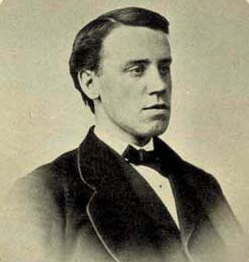
Joseph Lyman Silsbee was a significant American architect during the 19th and early 20th centuries. He was well known for his facility of drawing and gift for designing buildings in a variety of styles. His most prominent works ran through Syracuse, Buffalo and Chicago. He was influential as mentor to a generation of architects, most notably architects of the Prairie School including the famous architect Frank Lloyd Wright.

Viking ship replicas are one of the more common types of ship replica. Viking, the very first Viking ship replica, was built by the Rødsverven shipyard in Sandefjord, Norway. In 1893 it sailed across the Atlantic Ocean to Chicago in the United States for the World's Columbian Exposition. Formerly located in Lincoln Park, Chicago, Illinois, the Viking is currently undergoing conservation in Geneva, Illinois, United States.

The Statue of The Republic is a 24-foot-high (7.3 m) gilded bronze sculpture in Jackson Park, Chicago, Illinois by Daniel Chester French. The colossal original statue, a centerpiece of the World's Columbian Exposition in 1893, was ordered afterwards to be destroyed by fire. A smaller-scale replica sculpted by the same artist was erected in 1918 in commemoration of both the 25th anniversary of the Exposition and the Illinois' statehood centennial. The replacement statue is at the south end of the park at the intersection of East Hayes and South Richards Drive, adjacent to the golf course and approximately where the exposition's Administration Building and Electricity Building once stood. The statue was funded by the Benjamin Ferguson Fund, which commissioned French to cast this recreation of the original 65-foot-tall (20 m) statue that stood on the grounds of the Exposition of 1893. Edith Minturn Stokes served as French's model for the original statue. Henry Bacon, the architect of the Lincoln Memorial, designed the festooned pedestal for the replica.
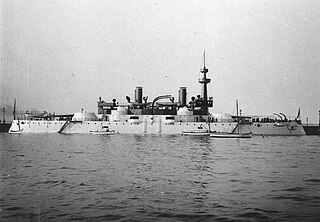
Illinois was a detailed, full-scale mockup of an Indiana-class coastal defense battleship, constructed as a naval exhibit at the World's Columbian Exposition in Chicago, Illinois, in 1893. It was built alongside a pier of stuccoed brick atop wood pilings, with a stucco covered wood-framed superstructure, and outfitted with limited mechanical systems and displays.
Robert Louis Asp was an American educator from Minnesota. He is known principally for his involvement building the replica ship Hjemkomst which sailed from Duluth, Minnesota to Bergen, Norway in 1982.
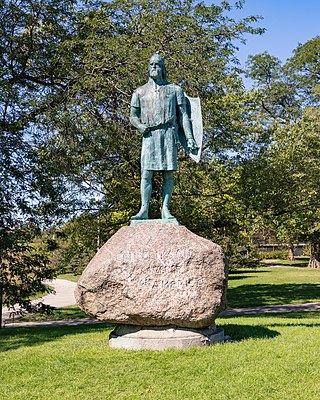
The Leif Erikson statue is a monumental statue honoring Leif Erikson in Chicago, Illinois, United States. Located in the city's Humboldt Park, the statue was designed by Sigvald Asbjørnsen and erected in 1901.

The Gaia ship is a replica of the 9th century Viking ship Gokstad ship. It was built in 1990 and departed Bergen for North America on 17 May 1991. It was named Hav-Cella prior to departing but was renamed Gaia by Vigdís Finnbogadóttir, President of Iceland, during a stopover in Iceland. Gaia is the name for the goddess of the Earth in Greek mythology. The Gaia Ship reached Newfoundland on 2 August and Washington DC on Leif Erikson Day, 9 October 1991. It further sailed to the Rio de Janeiro Earth Summit via the Faroe Islands, Iceland, Greenland, and North America.
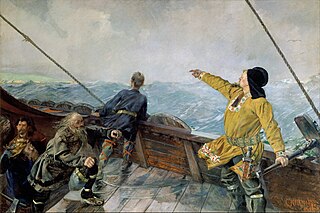
Leiv Eirikson Discovering America is a painting by Christian Krohg. It depicts the explorer Leif Erikson at the moment he discovers American land, as described in the sagas of Icelanders. The painting was made for the Chicago World's Fair in 1893 and was exhibited along with the Viking ship replica Viking. It is in the collection of the National Museum of Art, Architecture and Design in Oslo. A copy of the painting, created by Krohg's son, Per Krohg, has hung in the United States Capitol since 1936.
